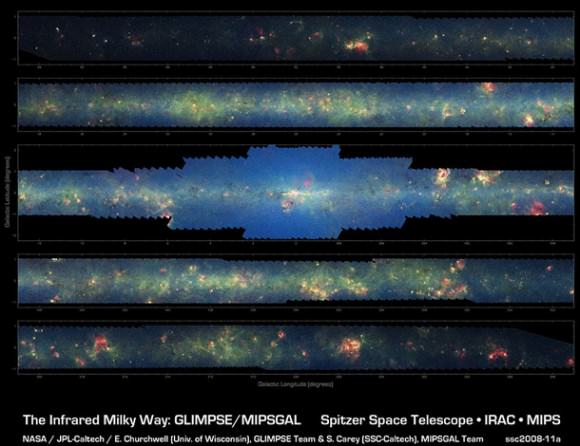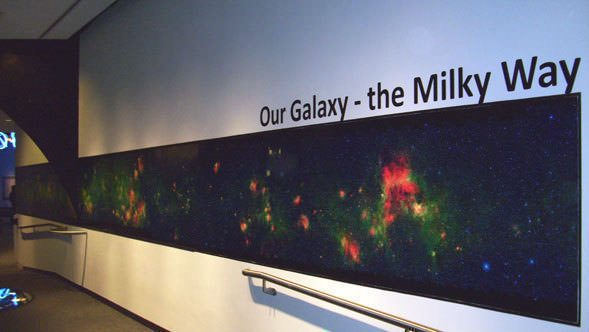[/caption]
Astronomy is all about getting the big picture of our place in the cosmos, but some pictures are bigger than others. This one is really big. The world’s largest image of our Milky Way galaxy went on display today at the Adler Planetarium in Chicago. The image spans an area of 37 meters (120 feet) long by 1 meter (3 feet) wide at its sides, bulging to 2 meters (6 feet) to show the center of our humongous galaxy. The panorama represents 800,000 separate images taken by the Spitzer Space Telescope over a five-year period.
“This is the highest-resolution, largest, most sensitive infrared picture ever taken of our Milky Way,” said Sean Carey of NASA’s Spitzer Science Center, speaking when the image was unveiled in 2008 at the American Astronomical Society meeting in St. Louis (see our article and image of the unveiling). “Where previous surveys saw a single source of light, we now see a cluster of stars. With this data, we can learn how massive stars form, map galactic spiral arms and make a better estimate of our galaxy’s star-formation rate.”

Data from Spitzer’s Infrared Array Camera (IRAC) and the Multiband Imaging Photometer were used to create the image.
If you want to download a very large version of this image (2400 x 3000) click here — warning: very big file.
From our vantage point on Earth, we see the Milky Way as a blurry, narrow band of light that stretches across the sky. In the visible, we only see about 5% of what’s actually out there. But with Spitzer’s dust-piercing infrared eyes, astronomers have peered 60,000 light-years away into this fuzzy band, called the galactic plane, and saw all the way to the other side of the galaxy.
The panorama reveals star formation as never seen before on both the large and small scale. Most of the star forming regions had not been seen before this project was undertaken.
I had the good fortune of seeing the image in St. Louis, and I highly recommend taking the opportunity to go see it at the Adler Planetarium if you are in Chicago. Here’s a video that explains how astronomers took the images and put them all together to form this gigantic panorama.
*Serendipitously, I am currently at the dotAstronomy conference where Eli Bressert from the Chandra X-Ray Center talked about the GLIMPSE Viewer. Here’s the link to see the Spitzer image with GLIMPSE (Galactic Legacy Infrared Midplane Extraordinaire).
Adler Planetarium is located at 1300 South Lake Shore Drive, Chicago, Ill., 60605. Phone: 312-922-7827. Adler Planetarium website. .


Another great way to take in this immense vista is by using the GLIMPSE Image Viewer: http://www.alienearths.org/glimpse/ . What a great way to see our home galaxy ( at least a 120 degree arc anyway)!
Jon- Thanks for noting GLIMPSE — I added it to the article after hearing a presentation about it today!